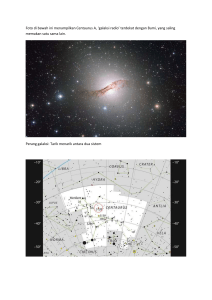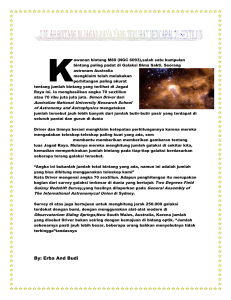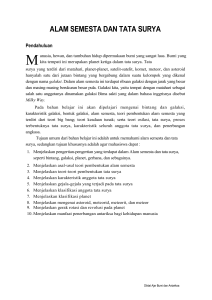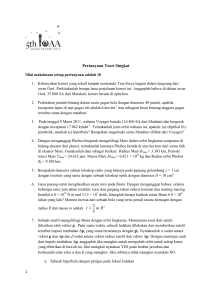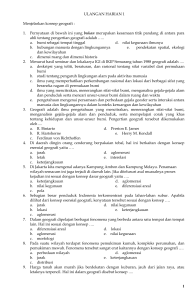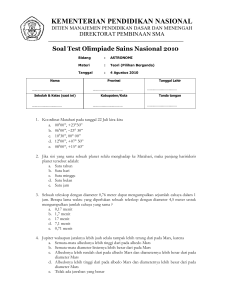galaksi - blogvenuz
advertisement
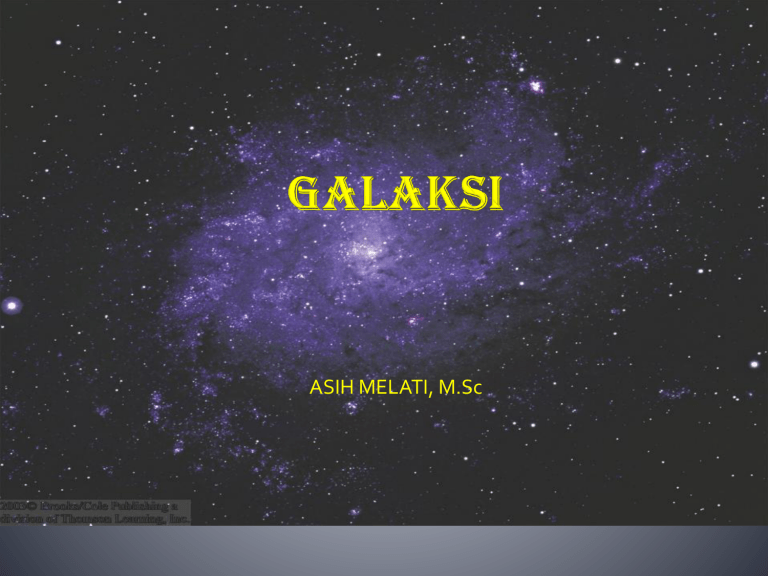
ASIH MELATI, M.Sc GALAKSI Galaksi adalah kumpulan berjuta-juta bintang, gas dan debu yang amat luas yang terikat bersama oleh gravitasi Menurut William Herschel galaksi merupakan Kelompok-kelompok bintang berbentuk piringan pipih seperti cakram Jalur putih yang membentang di langit dari utara ke selatan tampak seperti awan tipis Tampak seperti orang yang berkelahi dengan ular Dahulu orang percaya itu adalah bayangan bayangan bima Yang berkelahi dengan ular Pemahaman astronom mengenai bentuk galaksi BimaSakti, tidak terlepas dari perkembangan pengetahuan dimulai dari: a. Thomas Wright (1750): Matahari bersama bintang-bintang lainnya membentuk satu kelompok seperti pulau perbintangan di tengah-tengah jagad raya b. William Herschel (1784) : Kelompok bintang-bintang dalam galaksi Bima Sakti membentuk piringan pipih seperti cakram dan letaknya tidak merata bertaburan di langit c. Kapteyn (1910) : Wujud galaksi Bima Sakti adalah pipih. d. Hasil studi cacah bintang dari Harold Shapley (1917): Galaksi Bima Sakti berbentuk cakram dengan garis tengah 100.000 tahun cahaya, dan matahari berada di daerah tepi sekitar 30.000 tahun cahaya dari pusat galaksi. Berdasarkan bentuknya galaksi dibagi menjadi 3 yaitu: 1. Spiral 2. Elips 3. Tidak beraturan Galaksi yang berbentuk spiral berjumlah 80% dari galaksi yang ada. Galaksi ini memiliki struktur paling teratur terhadap pusat Contoh galaksi ini Bima Sakti, Galaksi Andromeda,dan galaksi Canes Venatici spiral Galaksi spiral diperkaya o/ gas dan debu Galaksi yang berupa gumpalan pekat disebut Galaksi Eliptik Galaksi yang berbentuk elips ber- jumlah 17% dari seluruh galaksi yang ada. Bentuk galaksi ini lebih sederhana dibanding galaksi spiral, kerapatan bintang lebih tinggi di pusat dibanding di tepinya Often: result of galaxy collisions / mergers Often: Very active star formation (“Starburst galaxies”) Some: Small (“dwarf galaxies”) satellites of larger galaxies (e.g., Magellanic Clouds Galaksi ini berjumlah 3% dari seluruh galaksi yang ada. Untuk mengukur galaksi dapat dilakukan dengan mengukur terang cahaya bintang Antara tahun 1912 sampai 1925 V.W. Slipher dari Observatorium Lowel di Amerika mengemukakan bahwa cahaya yang dipancarkan dari galaksi-galaksi warnanya bergeser ke arah panjang gelombang yang lebih besar artinya galaksi tersebut bergerak menjauhi kita Dari perubahan frekuensi tersebut para astronom menentukan kecepatan gerak menjauhi galaksi yang mencapai ribuan kilometer tiap detiknya Edwin Hubble pada tahun 1029 dari Observatorium Mount Wilson Amerika mengemukakan bahwa galaksi yang jauh bergerak lebih cepat dibandingkan galaksi yang jaraknya lebih dekat Galaksi yang berjarak 900 juta TC bergerak menjauh dengan kecepatan 20.000 km/detik Galaksi yg berjarak 1.800 juta TC bergerak dengan kecepatan 40.000 km/detik Hubungan antara jarak galaksi dan kecepatan ini dikenal dengan hukum Hubble a) Cepheid Method: Using Period – Luminosity relation for classical Cepheids: Measure Cepheid’s Period Find its luminosity Compare to apparent magnitude Find its distance b) Type Ia Supernovae (collapse of an accreting white dwarf in a binary system): Type Ia Supernovae have well known standard luminosities Compare to apparent magnitudes Find its distances Both are “Standard-candle” methods: Know absolute magnitude (luminosity) compare to apparent magnitude find distance. Repeated brightness measurements of a Cepheid allow the determination of the period and thus the absolute magnitude. Distance At very large distances, only the general characteristics of galaxies can be used to estimate their luminosities distances. Cluster of galaxies at ~ 4 to 6 billion light years E. Hubble (1913): Distant galaxies are moving away from our Milky Way, with a recession velocity, vr, proportional to their distance d: vr = H0*d H0 ≈ 70 km/s/Mpc is the Hubble constant • Measure vr through the Doppler effect infer the distance • Many galaxies are typically millions or billions of parsecs from our galaxy. • Typical distance units: Mpc = Megaparsec = 1 million parsec Gpc = Gigaparsec = 1 billion parsec • Distances of Mpc or even Gpc The light we see left the galaxy millions or billions of years ago!! • “Look-back times” of millions or billions of years Vastly different sizes and luminosities: From small, lowluminosity irregular galaxies (much smaller and less luminous than the Milky Way) to giant ellipticals and large spirals, a few times the Milky Way’s size and luminosity From blue / red shift of spectral lines across the galaxy infer rotational velocity Observe frequency of spectral lines across a galaxy. Plot of rotational velocity vs. distance from the center of the galaxy: Rotation Curve Based on rotation curves, use Kepler’s 3rd law to infer masses of galaxies Milky Way Small Magellanic Cloud Large Magellanic Cloud Andromeda galaxy Some galaxies of our local group are difficult to observe because they are located behind the center of our Milky Way, from our view point. Spiral Galaxy Dwingeloo 1 Cartwheel Galaxy Particularly in rich clusters, galaxies can collide and interact. Galaxy collisions can produce ring galaxies and NGC 4038/4039 tidal tails. Often triggering active star formation: starburst galaxies Example for galaxy interaction with tidal tails: The Mice Computer simulations produce similar structures. Numerical simulations of galaxy interactions have been very successful in reproducing tidal interactions like bridges, tidal tails, and rings. NGC 7252: Probably result of merger of two galaxies, ~ a billion years ago: Small galaxy remnant in the center is rotating backward! Radio image of M 64: Central regions rotating backward! Multiple nuclei in giant elliptical galaxies NGC 5194 • Collisions of large with small galaxies often result in complete disruption of the smaller galaxy. • Small galaxy is “swallowed” by the larger one. • This process is called “galactic cannibalism” M 82 Starburst galaxies are often very rich in gas and dust; bright in infrared: ultraluminous infrared galaxies Cocoon Galaxy Superclusters = clusters of clusters of galaxies Superclusters appear aligned along walls and filaments. Vast regions of space are completely empty: “voids”
